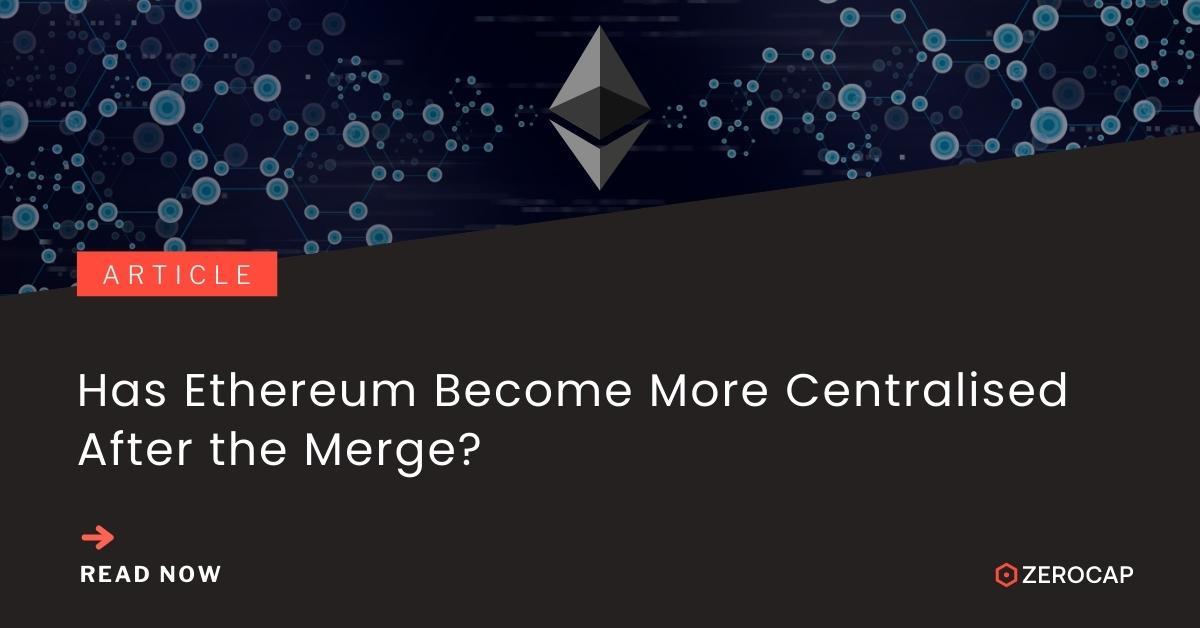Content
- The Impacts of The Ethereum Merge
- Proof of Stake’s Impact on Ethereum Centralisation
- Maximal Extractable Value (MEV)
- Flashbots and MEV-Boost
- Ethereum’s In-Protocol Proposer Builder Separation (PBS)
- Conclusion
- About Zerocap
- FAQs
- What is the Ethereum Merge and how does it impact decentralisation?
- How does Proof of Stake impact Ethereum's centralisation?
- What is Miner Extractable Value (MEV) and how does it relate to Ethereum's centralisation?
- How does Flashbots' MEV-Boost aim to prevent MEV from causing centralisation in Ethereum?
- What is Ethereum's plan to mitigate the centralisation of MEV after The Merge?
23 Nov, 22
Has Ethereum Become More Centralised After the Merge?

- The Impacts of The Ethereum Merge
- Proof of Stake’s Impact on Ethereum Centralisation
- Maximal Extractable Value (MEV)
- Flashbots and MEV-Boost
- Ethereum’s In-Protocol Proposer Builder Separation (PBS)
- Conclusion
- About Zerocap
- FAQs
- What is the Ethereum Merge and how does it impact decentralisation?
- How does Proof of Stake impact Ethereum's centralisation?
- What is Miner Extractable Value (MEV) and how does it relate to Ethereum's centralisation?
- How does Flashbots' MEV-Boost aim to prevent MEV from causing centralisation in Ethereum?
- What is Ethereum's plan to mitigate the centralisation of MEV after The Merge?
Decentralisation is a fundamental tenet of blockchains and their trustless nature. In most cases, decentralisation is derived from the base layer of a blockchain – the diversity of its nodes and how they reach consensus. As such, after The Merge, Ethereum arguably became more centralised due to a reliance on staking ETH rather than contributing mining power. This article will examine how The Merge positively and negatively impacted the decentralisation of Ethereum as well as other plights the blockchain faces that must be overcome to rid itself of the weed of centralised control.

The Impacts of The Ethereum Merge
The Ethereum Merge was a historical event whereby the blockchain shifted from one consensus mechanism, Proof of Work (PoW) to another, Proof of Stake (PoS), without halting block production. In this impressive feat, Ethereum’s Beacon Chain merged with its execution layer, altering the dynamics of staking on the blockchain. Instead of mining to earn ETH rewards, paying for the exorbitant mining equipment that can exceed costs of US$ 2k and the US$ 0.2 – US$ 0.5 per kWh, entities only need to stake their tokens in the network to participate.
Although staking tokens may appear to be a lower barrier of entry for validators than mining equipment was for miners, the minimum stake deposit per entity is 32 ETH. To distribute this cost, staking pools arose that serve the purpose of aggregating a multitude of addresses’ ETH to meet the 32 ETH requirement, ergo enabling more individuals to participate in validating the network, irrespective of their crypto wealth.
Proof of Stake’s Impact on Ethereum Centralisation
Under the PoS consensus mechanism, any entity can validate the network if they stake 32 ETH; this stake represents network collateral entities are putting up to earn rewards. If a validator acts maliciously or in a way that does reflect the network’s purpose, their stake will be slashed (burnt). With the combination of staking pools, the fundamental incentive of PoS is to increase Ethereum’s decentralisation by enabling more entities to participate in the validation of the blockchain. In this context, the more nodes that are involved in reaching consensus, the more decentralised Ethereum is; this aligns with Balaji Srinivasan and Leland Lee’s Nakamoto coefficient – a tool to quantify decentralisation.
Yet, many in the crypto community would argue that PoS had an antithetical effect on decentralisation, actually centralising network control with a smaller subset of participants. Given that few could satisfy the 32 ETH staking requirement, they instead turned to staking pools – the most popular of which being Lido. Consequently, despite more than 465k validators who are staking over 14.8 million ETH, a small number of wallets control over 53% of the ETH locked into the Beacon Chain. The control of these parties, most significantly Lido, which stakes more than 27% of all staked ETH, renders the impact of The Merge to be one of centralisation.
Maximal Extractable Value (MEV)
Miner Extractable Value or Maximal Extractable Value, more frequently known as MEV, is the fundamental value that can be captured by parties that have the power to include and order transactions in a block. Validators of a blockchain (miners and stakers), run bots that search for opportunities where they can insert their own transactions and increase their rewards.
The total MEV extracted on Ethereum since The Merge is estimated to be higher than US$ 52 million, however, capturing MEV comes with centralisation fears; this value will only be extracted by specialised coders with the capacity to develop MEV searcher bots. If MEV was only captured by a small number of parties, Ethereum would become centralised as these validators would grow their stake, increasing their likelihood of being selected to propose the subsequent block and extract more MEV. If left unchecked, this vicious cycle might have spelt the end of Ethereum’s decentralised nature.
Flashbots and MEV-Boost
To prevent MEV from causing centralisation in Ethereum, Flashbots, an R&D company based out of Ohio, emerged. The team was established with a focus on illuminating, democratising and distributing MEV by studying its risks and means to effectively track cumulative totals. With its searcher bots surveying the Ethereum mempool (pending transaction pool), Flashbots launched MEV-Explore, a page that published live data on MEV whilst Ethereum utilised the PoW consensus algorithm. As well as this, Flashbots released mev-geth, a client allowing all miners to capture MEV natively without relying on their own specialised knowledge to alter a client themselves.
However, subsequent to The Merge, mev-geth lost utility as it was not built for PoS. Consequently, Flashbots launched MEV-Boost – a PoS-focused validator client which increased accessibility to MEV, thereby democratising it and reducing centralisation risks. MEV-Boost implements Proposer Builder Separation (PBS) to distribute MEV to all validators; this concept divides the roles of building blocks of transactions, selecting the most profitable block and proposing the block on-chain into Builders, Relayers and Proposers.
Given the concept was highly effective in capturing more MEV for all validators, MEV-Boost has gained mass adoption; since The Merge, over 75% of blocks have been proposed by a validator leveraging MEV-Boost. Further, almost 400k of the total 465k Ethereum validators utilise MEV-Boost. Although this might spark worries of centralisation, Flashbots have created a competitive block builder market to decrease centralisation. However, centralisation concerns as a result of censorship have arisen following Flashbots’ compliance with the US Office of Foreign Assets Control (OFAC) sanctioning Tornado Cash. As a US-regulated company, Flashbots has prevented relayers from sending blocks to proposers that breach OFAC regulations. Accordingly, 76% of all blocks proposed with Flashbots’ MEV-Boost since The Merge have been OFAC compliant; thus, these blocks censor certain transactions due to a single point of failure – Flashbots.
Ethereum’s In-Protocol Proposer Builder Separation (PBS)
Despite the fact that the capture of MEV must be available to all validators to prevent the centralisation of staked Ethereum and network control, the solution cannot be actualised by a single company. Instead, the democratisation of MEV in PoS must be native to Ethereum so as to obtain the trustless, decentralised nature of the blockchain. As such, in-protocol PBS to mitigate the centralisation of MEV after The Merge has been added to the Ethereum roadmap; as part of The Scourge stage of the recently updated roadmap, PBS will be integrated into the blockchain at the base layer.
However, the implementation of this concept requires consideration of edge cases. One such case is how to decentralise the parties behind block relayers so that proposers do not need to trust a single source of information. Furthermore, an effective in-protocol PBS will see blocks being encrypted until they are proposed so as to mitigate theft-related strategies. Moreover, another edge is how to influence block builders to not censor transactions without applying significant degrees of pressure and subsequently creating new forms of censorship. For these reasons, PBS will not be enshrined in Ethereum for “the next year or two” according to Stephane Gosselin, co-founder of Flashbots.
Conclusion
Ultimately, although The Merge heralded benefits for Ethereum, it has also introduced threats to the blockchain’s decentralisation. At the base layer, the existence of a centralisation cycle whereby larger amounts of ETH staked leads to more rewards and hence more tokens staked, is a clear path to undermining Ethereum’s highly regarded decentralised nature. To prevent Ethereum from descending into the depths of centralisation, developers, network participants and the wider community must remain vigilant with regard to the introduction of models that gives more control to those with more ETH.
About Zerocap
Zerocap provides digital asset investment and digital asset custodial services to forward-thinking investors and institutions globally. For frictionless access to digital assets with industry-leading security, contact our team at [email protected] or visit our website www.zerocap.com
This material is intended for illustrative purposes and general information only. It does not constitute financial advice nor does it take into account your investment objectives, financial situation or particular needs. You should consider the information in light of your objectives, financial situation and needs before making any decision about whether to acquire or dispose of any digital asset. Investments in digital assets can be risky and you may lose your investment. Past performance is no indication of future performance.
FAQs
What is the Ethereum Merge and how does it impact decentralisation?
The Ethereum Merge was a significant event where the blockchain transitioned from a Proof of Work (PoW) consensus mechanism to a Proof of Stake (PoS) system. This change has led to debates about Ethereum’s decentralisation. While PoS allows more entities to participate in validating the network, the requirement to stake 32 ETH has resulted in the rise of staking pools, potentially leading to centralisation.
How does Proof of Stake impact Ethereum’s centralisation?
Proof of Stake (PoS) allows any entity to validate the network if they stake 32 ETH. While this system aims to increase Ethereum’s decentralisation by enabling more entities to participate in the validation process, the high staking requirement has led many to use staking pools. This has resulted in a small number of wallets controlling a significant portion of the ETH locked into the Beacon Chain, leading to concerns about centralisation.
What is Miner Extractable Value (MEV) and how does it relate to Ethereum’s centralisation?
Miner Extractable Value (MEV) is the value that can be captured by parties that have the power to include and order transactions in a block. If MEV is only captured by a small number of parties, Ethereum could become centralised as these validators would grow their stake, increasing their likelihood of being selected to propose the subsequent block and extract more MEV.
How does Flashbots’ MEV-Boost aim to prevent MEV from causing centralisation in Ethereum?
Flashbots, an R&D company, launched MEV-Boost, a PoS-focused validator client which increases accessibility to MEV, thereby democratising it and reducing centralisation risks. MEV-Boost implements Proposer Builder Separation (PBS) to distribute MEV to all validators. Since The Merge, over 75% of blocks have been proposed by a validator leveraging MEV-Boost.
What is Ethereum’s plan to mitigate the centralisation of MEV after The Merge?
To prevent MEV from causing centralisation, Ethereum plans to integrate in-protocol Proposer Builder Separation (PBS) into the blockchain at the base layer. This concept divides the roles of building blocks of transactions, selecting the most profitable block and proposing the block on-chain into Builders, Relayers and Proposers. However, the implementation of this concept requires consideration of edge cases and is expected to take a year or two.
Like this article? Share
Latest Insights
Interview with Ausbiz: How Trump’s Potential Presidency Could Shape the Crypto Market
Read more in a recent interview with Jon de Wet, CIO of Zerocap, on Ausbiz TV. 23 July 2024: The crypto market has always been
Weekly Crypto Market Wrap, 22nd July 2024
Download the PDF Zerocap is a market-leading digital asset firm, providing trading, liquidity and custody to forward-thinking institutions and investors globally. To learn more, contact
What are Crypto OTC Desks and Why Should I Use One?
Cryptocurrencies have gained massive popularity over the past decade, attracting individual and institutional investors, leading to the emergence of various trading platforms and services, including
Receive Our Insights
Subscribe to receive our publications in newsletter format — the best way to stay informed about crypto asset market trends and topics.



 Share
Share  Tweet
Tweet  Post
Post 